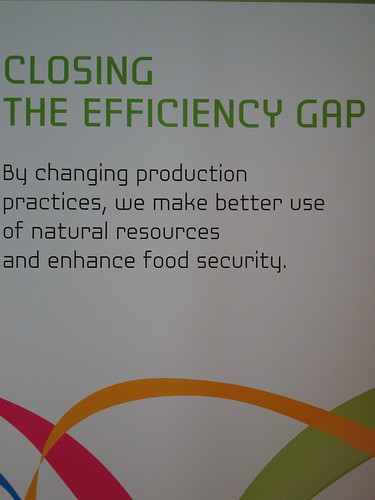One of three objectives of the Global Agenda of Action in Support of Sustainable Livestock Sector Development. Its Third Multi-Stakeholder Platform Meeting was co-hosted in Nairobi, Kenya, by ILRI, FAO and AU-IBAR, 22-24 Jan 2013 (photo credit: ILRI/Susan MacMillan).
Guest blog post by ILRI’s Simon Fraval
In collaboration with the Food and Agricultural Organization of the United Nations (FAO) and the Kenya Ministry of Livestock Development, researchers at the International Livestock Research Institute (ILRI) are assessing the feasibility of the Kenyan dairy industry obtaining payment for its environmental services through productivity gains. (See this ILRI position paper for more information on ‘payment for environmental services’ schemes).
Reducing the level of greenhouse gases generated per unit of milk produced by smallholder farmers could be attractive to environmental markets. While this project will not provide direct money transfers to Kenya’s dairy farmers, it will support agricultural extension for better cow nutrition and other interventions made to increase milk production while also reducing emissions of greenhouse gases per unit of milk.
The concept gained momentum at an interim preparatory committee meeting of the Global Agenda of Action in Support of Sustainable Livestock Sector Development held in Rome in September 2012.
The Global Agenda is committed to broad-based, voluntary and informal stakeholder actions improving the performance of the livestock sector. It ambitiously aims to protect natural resources as well as to reduce poverty and protect public health. The Agenda’s stakeholders have agreed initially to focus on the following three objectives: Close the efficiency gap in livestock production systems, restore value to grasslands’ environmental services and sustainable livelihoods, and recover and recycle nutrients and energy contained in animal manure. The Agenda is working to achieve these objectives largely through consulting and networking, analyzing and informing, and guiding and piloting.
Progress on the Kenya dairy pilot ‘payment for environmental services’ project was presented at the third multi-stakeholder platform meeting of the Global Agenda, held in Nairobi, Kenya, 22–24 January 2013. This project provided a practical example of the Agenda’s core activity in piloting novel approaches to ‘close the efficiency gap’. The presentation to the Global Agenda meeting can be found on its Livestock Dialogue website.
A stakeholders’ workshop on a pilot ‘payment for environmental services’ project for Kenya’s dairy industry was held in Jan 2013. Pictured left to right: Luke Kessei, Kenya Ministry of Livestock Development; Julius Kiptarus, Director of Livestock Production in Kenya’s Ministry of Livestock Development; Pierre Gerber, Food and Agriculture Organization of the United Nations; and Isabelle Baltenweck, ILRI (photo credit: MLD/Henry Ngeno).
Following the progress update provided at the mid-January 2013 Global Agenda meeting, a stakeholder workshop was held later in the month (29 Jan 2013) engaging representatives from the Kenya Dairy Board, the Kenya Agricultural Research Institute, the Kenya Dairy Processors Association, Kenyan livestock and cooperation ministries, development organizations and ILRI. The workshop was attended by Julius Kiptarus, Director of Livestock Production in Kenya’s Ministry of Livestock Development.
Stakeholders of the pilot ‘payment for environmental services’ project for Kenya’s dairy industry discussed the intricacies of such schemes, particularly carbon markets; site selection; potential greenhouse gas mitigation activities; and the design of a feasibility study. View slide presentations from this workshop here.
This pilot project is the first to access markets for payment for environmental services schemes through productivity gains in smallholder livestock enterprises. With the setting of this precedent and development of an internationally recognized methodology, development organizations will be able to replicate this pilot project and draw funding from the carbon market and other providers of ‘payment for environmental services’ schemes.
For more information, please contact Simon Fraval, a volunteer with AusAID’s Australian Youth Ambassadors for Development program placed at ILRI’s Nairobi headquarters, where he supports CGIAR research programs on ‘Climate Change, Agriculture, and Food Security’ and ‘Livestock and Fish: More meat, milk and fish by and for the poor’. Fraval brings to ILRI expertise in livestock value-chain development and life-cycle assessment. Contact him at s.fraval [at] cigar.org


